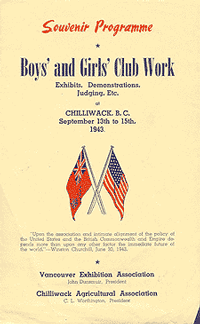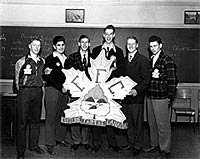
The first registered Junior Farm Clubs were organized in the Fraser Valley in the spring of 1929 under the Department of Agriculture. Mr. R. G Sutton was appointed District Agriculturist, headquartered at New Westminster and oversaw their activities. Initially four clubs were formed in the Fraser Valley, and of these clubs, a swine club was formed in Chilliwack with eight members sponsored by the local fair association.
The Jersey Calf Club was formed in Chilliwack in the same year, and sponsored by the Jersey Breeders Association. In 1930, a short-lived Beef Club was organized but folded after only one year, until in 1955 when Oliver Wells started a new club. Several dairy breed clubs existed in the area and each organization had large memberships.
In June 1946, a District Agriculturist was appointed for Chilliwack and Mr. Arthur E. Donald was selected for the position. At the same time as the creation of this new position, clubs in the Fraser Valley were divided into two supervised areas, but remained closely connected and mutual co-operation benefited both groups. Field days and meetings were opportunities for both groups to meet and visit with each other thereby sharing with each other their communications on local events and developments.
Fraser Valley judging teams provided many teams representing British Columbia at the Royal Winter Fair in Toronto. The first judging team was sent to Toronto in 1931, and of these teams, ten teams were sent from Chilliwack.
Prior to 1948, a Junior Farm Club grant existed that assisted the owners of the top four calves from every club locality in the Fraser Valley to attend the Chilliwack Fair. In 1948, the Dominion grant that supported both boys' and girls' work was lost to all fairs and as a result, there was no outside competition at the 1948 Chilliwack Fair. Organizers however, encouraged the club's continued success by promoting its usefulness and importance to the member's parents. By providing co-operative learning opportunities between parents and children, it was intended that the spirit that drove these clubs would continue. Parents could provide encouragement and ensure that rules were followed and that club work would be completed in a satisfactory manner.
In 1951, the Junior Farm Clubs name, "Canadian Boys' and Girls' Clubs" was changed to 4-H, a name that was adopted across Canada. The emblem adopted by the new, but same movement was a four-leaf clover representing good luck and achievement with an "H" within each leaf. Each letter represented a portion of the club's creed, "Head, Heart, Hands and Health."
Chilliwack, organized under the new banner, held an organizational meeting later in 1951 that would see the creation of the first junior 4-H council in the province. Throughout the 1950s, there was an increase in the number of new clubs formed as, sewing, tractor, poultry, lamb and cooking clubs were created. During the 1960s a change was made to the age range of children within the clubs, and changed from 9 to 19. In addition, the 4-H movement continued its innovations by developing dress revues, judging rallies, camping and exchanges between clubs. By 1971, light horses were accepted as 4-H projects and became so popular that five Chilliwack clubs developed. Towards the end of the 1970s, both a goat and a dog club were formed.
The legacy of the older 'Junior Farm Clubs' and it antecedent club, "4-H" is their advocacy in training youth in the arts of citizenship, a role they remain committed to developing and promoting at the many agricultural fairs that remain in existence today.


Local 4H club showing their Ayrshire cows at the Chilliwack Exhibition, ca. 1940s. AM 105.
Newly elected executive of the Future Farmers of Canada pose with their group crest. 1997.11
Local 4H club showing their Ayrshire cows at the Chilliwack Exhibition, ca. 1940s. AM 105.
